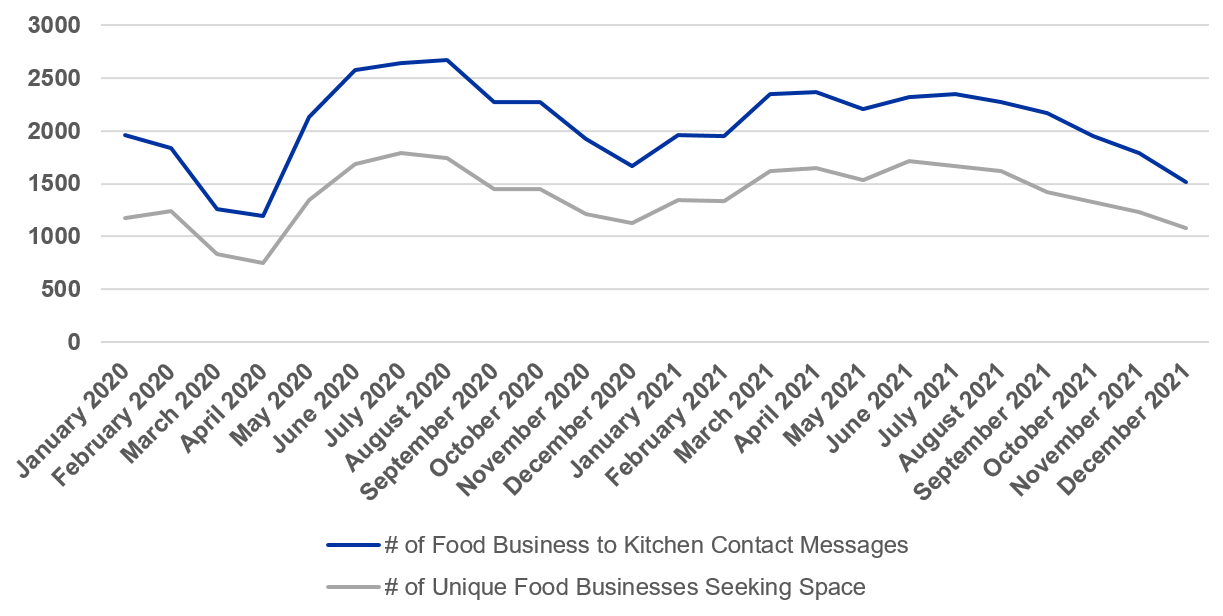Demand for Certified Kitchen Use Nationally and in Kentucky
Author(s): Camille Dant
Published: January 28th, 2022
Shareable PDF
Many Certified Kitchens saw a shock to their system and a halting of kitchen rentals and revenue as COVID-19 made its impact. Certified or commercial kitchens, also known as shared use kitchens, are commercially-licensed spaces where producers can prepare their products legally while providing budget and schedule flexibility that small businesses may need. Nationally and locally, these kitchens saw shifts in demand for the use of their space. According to The Nick[1], there was a 30% reduction in bookings and revenue when stay-at-home orders were put in place in early 2020. However, when the orders were lifted many people returned to using the kitchens. While some still closed their operations fully, new users of the kitchens began to utilize them with their focus being delivery-only restaurants.
Hailey Edmondson, Sales Development Manager with The Food Corridor[2], provided some insight on how the demand for shared kitchens was faring nationally. Demand for shared kitchen space plummeted in March and April of 2020 as shown in Figure 1. With COVID-19 restrictions in place, the use of a shared kitchen was not in the cards for many of the producers they serviced. Kitchen space demand picked up sharply in May of 2020, largely in tandem with the growth in consumer interest in local food products and direct market channels. New unique food businesses seeking kitchen space increased 140% from April 2020 to June 2020, to nearly 1,700 unique food businesses. The demand for use of the shared kitchens may have stemmed from many factors including opening food businesses due to layoffs or furloughs or even some established restaurants renting out part of their kitchen to make up for decreases in profit.
Figure1: Demand for Shared Kitchen Space
January 2020 - December 2021

The demand for shared kitchen use has leveled off nationally. However, according to Hailey, it is still above the demand they observed pre-pandemic. Will the changes that have been made over the course of the past two years keep demand for the commercial kitchens growing or will it plateau? The data show that even with a pandemic, demand continues to increase as more and more consumers are asking for specific value-added products and more producers are willing to meet those demands. Producers have the opportunity through these kitchens to expand past their current business plan into new local markets. With many consumers asking for local products, ready-to-heat meals, and even curated CSA packages utilizing products from different producers, these certified kitchens have plenty of opportunities for producers to expand their businesses.
Local to Kentucky, the Incubator Kitchen Collective[3] saw an increase in products being shipped last year as well as businesses the kitchen was supporting. Kentucky has a strong farmers market presence with over 2,700 vendors, a large home-based processing base, and a growing KY Proud branding program that has raised the marketing profile for local products. There are a total of 43 commercial kitchens for rent across the Commonwealth. Of that 43, 13 of the kitchens are housed within county Cooperative Extension Service offices. A list of current certified kitchens in Kentucky is available at the UK Food Systems Innovation Center site and maintained by Annhall Norris of Family Consumer Sciences. Additional training and support for kitchens and value-added product vendors is available from the UK FSIC; Kandi Williams, Coordinator, FSIC@uky.edu. See the additional links for more information in regards to certified kitchens.
- The Food Corridor
- The Nick (Network for Incubator & Commissary Kitchens)
- Commercial Kitchens in Kentucky
- Local and Regional Food Systems Response to Covid
[2] Source: The Food Corridor, NICK, (Hailey Edmondson), January 2022
Recommended Citation Format:
Dant, C. "Demand for Certified Kitchen Use Nationally and in Kentucky." Economic and Policy Update (22):1, Department of Agricultural Economics, University of Kentucky, January 28th, 2022.
Author(s) Contact Information:
Camille Dant | Extension Associate | camille.dant@uky.edu
Recent Extension Articles
Inflation - "Good" or "Bad" for Agricultural Producers and Consumers?
January 28th, 2022
Inflation has been headline news for several months and certainly an issue impacting all businesses, industries, and all of us as consumers. Last year the monthly inflation rate averaged just under 5% and in its latest report (January 12, 2022) the BLS indicated that prices over the past 12 months increased 7% -- the largest December to December percent change since 1981.
The Dairy Gauge Benchmarking Tool
January 28th, 2022
Benchmarking compares your farm’s performance to past performance or to established measures of success. The benchmark is some measure of a goal, or a range of what is desirable and what is not. You do this all the time, comparing this year’s yields to past years or this cow’s performance to others in the herd. These comparisons lead to informed decision-making, especially in managing the cow herd. Comparing your business performance is far less common, especially to the performance of other dairies.




